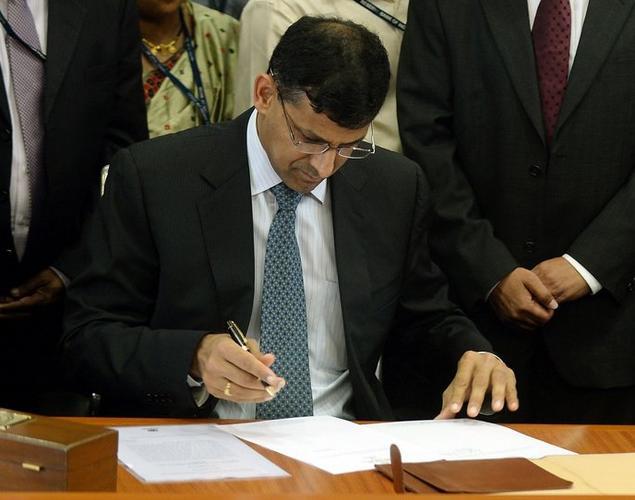September 20, 2013
The new Reserve Bank of India governor Raghuram Rajan surprised markets with a bold decision to hike interest rates on fears of rising inflation. Rajan increased the benchmark interest lending rate to 7.50 percent from 7.25 and in reaction the Bombay Stock Exchange's index of leading shares fell by 2.88 percent.

September 20, 2013
The new Reserve Bank of India governor Raghuram Rajan surprised markets with a bold decision to hike interest rates on fears of rising inflation. Rajan increased the benchmark interest lending rate to 7.50 percent from 7.25 and in reaction the Bombay Stock Exchange's index of leading shares fell by 2.88 percent.

Reserve Bank of India's (RBI) newly appointed governor Raghuram Rajan signs official papers during the hand over ceremony at the RBI headquarters in Mumbai on September 4, 2013
India's new central bank governor surprised markets Friday with a bold decision to hike interest rates on fears of rising inflation, triggering sharp falls on the stock market.
Reserve Bank of India (RBI) chief Raghuram Rajan, who had earlier warned he was prepared to be unpopular, increased the benchmark interest lending rate to 7.50 percent from 7.25 at his first policy review meeting since taking the reins.
The Bombay Stock Exchange's index of leading shares fell by 2.88 percent to a day's low of 20,051.43 points, led by a tumble in banking stocks. The Sensex recovered slightly in early afternoon to 20,183.60 points.
"Bringing down inflation to more tolerable levels warrants raising the repo rate by 25 basis points immediately," Rajan said.
He had been widely forecast by economists to keep rates on hold despite annual inflation hitting an unexpected six-month high of 6.1 percent this week.
While businesses and the government would like a rate cut to help revive sluggish growth, this would risk pushing inflation higher and further weakening the rupee, which hit record lows in the weeks before Rajan took charge on September 4.
Rajan did, however, relax some exceptional liquidity tightening measures introduced by the RBI in July to try and help stem the rupee's freefall.
The cash reserve ratio, the amount banks must set aside with the central bank as reserves, was reduced to 9.5 percent from 10.25 percent while the marginal standing facility — used to lend to commercial banks when there is a shortage of funds in the market — was cut by 75 basis points.
"Now things are back to normal, he is using the policy rate to target inflation and that will allow the rupee to do what it likes," Daniel Martin, Asia Economist at Capital Economics, told AFP.
Nicknamed "The Guv", Rajan stepped up to the post faced with the unenviable task of propping up a weak rupee, reviving slowing economic growth and curbing rising inflation.
"Absolutely we want to fight inflation and we will bring inflation down, but it is not a 'take no prisoners' kind of stance," he told reporters in India's financial hub Mumbai after Friday's meeting.
"The priorities of the central bank have always been inflation and growth. The emphasis on each varies with conditions."
Huge expectations have been riding on the former International Monetary Fund chief economist, who famously predicted the 2008 global financial crisis and has been lionised by India's media.
After taking over the job, he immediately announced a string of measures to liberalize financial markets and support the currency.
Rajan's efforts to swell foreign exchange coffers have helped the rupee rebound to reach around 62 to the dollar, from 67 when he took charge.
Easing global market concerns over an end to the US Federal Reserve's stimulus plan, attacks on Syria and rising oil prices have also aided the rupee's recovery.
While the Fed made a shock decision earlier this week to keep its aggressive stimulus program intact, Rajan said India has to "put our house in order" before any future US tapering occurs.
"We must use this time to create a bullet-proof national balance-sheet and growth agenda which creates confidence in citizens and investors alike," he said.
The rate increase was criticized by business groups such as the Confederation of Indian Industry (CII), which said the move "could have been avoided".
"Industry is already reeling under pressures of high cost of capital and low availability in a tight liquidity situation," a CII statement said.
The Indian economy grew by just five percent last year, its slowest pace in a decade, and some private economists forecast expansion this year at under four percent.
Meanwhile, the Congress-led government has become mired in graft scandals and policy paralysis that have sunk its popularity and sent foreign investors fleeing.
India's public finances are also in trouble with the current account deficit — the broadest measure of trade – hitting a record high last year.
Courtesy: AFP
















































































































